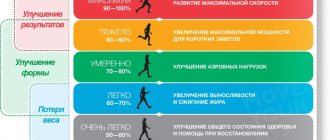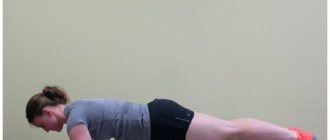Pulse zones are heart rate (heart rate) parameters at which any workout will have a specific effect on the body. Both beginners in sports and professionals need to know them, since adherence to the zones makes training safe for the heart, blood vessels and respiratory organs.
The simplest formula for calculating the maximum heart rate is “220 – the person’s age,” but there are other options; the optimal one is to undergo an examination and determine the necessary parameters by medical professionals.
Five pulse zones help to divide the workout into time intervals and give a certain load in each of them - from the weakest to the maximum, when the work of the whole body proceeds to the limit of its capabilities.
What are pulse zones, or heart rate zones?
Pulse zones, or heart rate zones, are the range of heart rate parameters at which a certain type of physical activity will have a specific effect on the body. To determine them, you need to know your own pulse values “at rest” and the maximum permissible heart rate, which is calculated using a formula strictly on an individual basis.
Training based on pulse zones makes it possible to load the body according to your goals - for weight loss, increasing endurance, building muscle mass, and so on.
What are the heart rate zones?
There are 5 heart rate zones, each of which has its own characteristics and maintenance conditions.
| Pulse zone number | Percentage of increase in heart rate in relation to maximum heart rate values | Brief Explanation |
| The first is light aerobic | 50-60% | It is considered a warm-up and does not have a positive effect on physical development, but it must be completed as a warm-up before each workout. |
| The second is fat burning | 60-70% | The body receives the energy it needs to work from already stored fats, and the heart muscle is effectively trained |
| The third is aerobic | 70-80% | It is considered the most comfortable zone for performing daily physical activity; a large amount of oxygen begins to enter the body |
| The fourth is anaerobic | 80-90% | It involves intense training, oxidative processes begin to occur in the muscles without the direct participation of oxygen. |
| Fifth - maximum load | From 90% | The training takes place on the verge of physical strength, fatigue quickly sets in, severe muscle pain occurs; it is impossible to constantly exercise in this mode |
Aerobic
Aerobic pulse zone - implies achieving a pulse rate within 80-90% of the maximum permissible heart rate; for an adult this will average 135-150 beats per minute. It is considered the most comfortable and effective zone for performing endurance training. When training in this mode:
- small blood vessels are strengthened and expanded;
- lung volume increases;
- the performance of the heart increases;
- the heart muscle is strengthened.
During physical activity in the aerobic pulse zone, lactic acid begins to enter the bloodstream, which contributes to partial muscle growth.
Target
The target heart rate zone is the one that helps achieve the desired effect from training. For example, the first zone (easy) cannot be targeted because:
- implies an increase in heart rate within 50-60% of the maximum heart rate;
- the load only makes it possible to adjust the functioning of the respiratory system;
- the heart works with minimal load.
But any other pulse zone can be considered a target zone - for losing weight, increasing physical endurance, and growing muscle mass.
Fat burning zone
The fat burning pulse zone falls in the range of 70-80% of the maximum heart rate. During training in this zone, metabolic processes in the body proceed in such a way that to obtain energy, fats are required, of which there is a lot in deposits. The result of regular physical activity in this heart rate range will be:
- reduction of the subcutaneous fat layer;
- weight loss due to the “burning” of fat deposits.
The desired fat burning effect will be difficult to achieve with just a light walk and simple exercises from the “school exercise” complex. For efficiency, it is recommended to walk at a high pace, use hills/stairs, and switch to easy running.
Training loads
The zone of expressed training loads begins in the range of 90% of the maximum heart rate. In fact, the variation is small - as soon as the indicator reaches 95%, the transition to the maximum permissible heart rate zone occurs. The second name for training loads is the anaerobic zone, which has the following characteristics:
- oxygen carried by the blood enters the tissues in limited quantities;
- burning of fat deposits is practically not carried out;
- the necessary energy is “extracted” from carbohydrates.
A “side effect” of such training is considered to be intense production of lactic acid, which provokes severe muscle pain - it will not be possible to load the body in such a pulse zone for a long time. But it is anaerobic exercise that is considered the most effective in increasing the overall endurance of the body and the growth of muscle fibers.
Maximum Load Zone
As soon as the pulse approaches 100% of the maximum heart rate, the maximum load zone begins - the heaviest, when the body works at the limit of its capabilities. This pulse zone allows you to burn the largest number of calories, but at the same time all oxidative processes occur without the participation of oxygen, and the respiratory organs and heart work at the limit.
Such training is suitable exclusively for professional athletes and only in the pre-competition period. If a person starts playing sports with the goal of improving health, losing weight or building moderate muscle mass, then they become impractical and even dangerous.
Optimal norms for fat burning while running
When running, you should adhere to the following standards:
- The optimal heart rate when running is 110-120 if the runner is a beginner. Here you should stick to jogging>regular stride when reaching your peak. For those who are prepared, the range is 130 to 145. “Starting small” is necessary for the normal functioning of the circulatory system and its gradual improvement.
- The anaerobic range must be calculated individually, because this ensures the highest quality results.
- To complete the picture and make the exercise more comfortable, you should use a heart rate monitor.
- In hot weather, it is necessary to maintain a decent level of water in the body. If you almost completely stop drinking while running, your heart rate soars to “cosmic levels” with extremely unfavorable consequences in the future.
- Often during and after running, the body temperature is between 38 and 39 degrees. This temperature is normal for training, which is an advantage during colds - forcing or maintaining temperature while running helps in recovery from a viral or common cold.
- If pain occurs in the lateral parts of the abdomen, you need to do one of two things - massage the abdominal cavity or slow down your running pace. Pain in these areas is associated with excess blood in this area and it is necessary to distribute it.
Calculating the optimal heart rate for burning excess weight is necessary for the effectiveness of the exercises. Pulse is an excellent indicator of how effectively and correctly the exercises are performed.
Pulse zones and training: why they are important to know
Pulse zones need to be known to all people who want to carry out regular training and protect their own body from overload: if you do not comply with the ranges, then it is possible to develop atrioventricular block of a physiological nature of the 2nd degree - this is how the heart reacts to overload, the pulse rate will begin to decrease noticeably, and this is dangerous for the entire circulatory system.
In addition, understanding the essence of pulse zones makes it possible to use physical activity with maximum efficiency - for example, those losing weight can create their own workout schedule, taking into account the fact that the heart rate should be increased by 60-70% at least.
As soon as this threshold is passed, namely, the expressed ease of performing the workout is felt, you can move on to the next heart rate zone. In this rhythm, fats will be burned more intensively, and the formation of the muscle frame will begin, which automatically helps to tighten the skin.
Metabolism in the body
The basis for the functioning of each organism is constant metabolism. The source of energy is organic substances in the form of proteins, fats and carbohydrates, which are broken down in the body under the influence of enzymes. The speed of these processes depends, among other things, on external circumstances and can be adjusted through physical activity.
When a person exercises at moderate intensity for a short period of time, less than 30 minutes, the body primarily uses carbohydrates (onosaccharides, disaccharides and polysaccharides) as fuel. In the digestive tract, polysaccharides (starch, glycogen; fiber and pectin are not digested in the intestine) and disaccharides, under the influence of enzymes, are broken down into monosaccharides (glucose and fructose), which are absorbed into the blood in the small intestine. A significant portion of monosaccharides enters the liver and muscles and serves as material for the formation of glycogen.
If the training time is more than 45 minutes, at low to medium intensity, the process of lipolysis begins, the metabolic process of breaking down fats into their constituent fatty acids. Lipolysis is the most important energy process in the cell, which ensures the synthesis of the largest amount of ATP (a universal source of energy for all biochemical processes occurring in living systems).
If the intensity of the workout increases, the body's need for oxygen also increases, which helps glycogen break down faster. During intense exercise, the body can quickly obtain energy only from glycogen due to the release of ATP molecules, all oxygen is reoriented to it. Glycogen reserves in the body are an order of magnitude lower than fat reserves, making it much more beneficial for the body to break down fats.
Please note: in order to get rid of extra pounds, the most effective and efficient option is aerobic exercise for 30-45 minutes: race walking, exercise in a swimming pool, running.
Heart Rate Training Pyramid
The pyramid of the pulse zone of training implies training in all zones, but taking into account the individual characteristics of the body: the most effective workouts are those that take place 80% in pulse zones 1-2 (the easiest - recovery and fat burning) and 20% in the rest ( cardio, endurance, maximum). But you need to take into account the general fitness of the person:
- if the goal is weight loss, and the initial weight is very large, then the entire workout should take place only in 1 pulse zone (recovery, warm-up);
- you can move on to the next zone only after the body gets used to the previous one, and the whole workout will be too easy, even without increased breathing;
- Even with maximum endurance and many years of sports, going through all the pulse zones is mandatory during one workout - it is strictly forbidden to proceed to the anaerobic pulse zone without preliminary “warming up”.
The time to “pass” each zone should also be determined individually. The first or second can last 2-10 minutes, the third – 40-50 minutes, if the goal is weight loss and figure correction.
How to dress for different weather
Sardana Trofimova: We have a cold winter in Yakutsk, so at home I train down to -30°C. When it’s very cold, I leave for training camp. I dress so that when I go outside I don’t feel hot. It should be a little chilly. If you dress warmly, you will sweat a lot, and at the end of the distance you may get winded.
We also run at -50°C, but there we need completely different equipment. This is extreme for most amateurs, but it also has its advantages, because in addition to training functionally, you also train your muscles: you have a lot of clothes, they interfere with movement. When you run in the snow, you feel slippery, and you also improve your physics.
Recommendations for conducting heart rate training
Experts advise regarding heart rate training:
- beginners should alternate the first 4 pulse zones throughout the entire workout, the longest is the first (warm-up), the shortest is 4 (anaerobic);
- if you are already trained, you can ignore the first pulse zone and start training from the second;
- after an intense workout, you must return to the second and first pulse zones;
- if a person is jogging, then it is better to start with a heart rate of 120 beats per minute - you need to hold out for at least 30 minutes (this is enough for the first time);
- To determine your pulse zone, you can measure your pulse every 3-5 minutes of exercise and adjust the load.
All recommendations relate only to healthy people, and the formulas for calculating the maximum heart rate are very approximate. Experts recommend being examined by doctors and taking heart rate and resting pulse readings using special equipment such as a treadmill or bicycle ergometer. And the presence of a history of cardiovascular diseases generally makes it necessary to conduct training by an experienced instructor and strictly within the framework of medical recommendations.
Heart rate zones help determine the right training intensity to achieve a specific goal. To clearly delineate pulse zones, you will need to measure your pulse at rest and calculate the maximum heart rate. By giving your body loads strictly according to pulse zones, you can not only achieve your goals (health improvement, weight loss, muscle growth), but also protect your heart and blood vessels from overload.
What is long-distance running and how to prepare for it
Vasily Permitin: According to official terminology in athletics, long distances are 5,000 and 10,000 meters and a half marathon. But usually this includes the marathon. Interesting fact: when we talk about running at a stadium, we talk about the distance in meters – running 5,000 and 10,000 meters. If we talk about the highway – 5 km, 10 km. Some people don't know this and get confused.
The main feature of long distances is that they are run in an aerobic mode. Therefore, during preparation, a large volume of slow running is necessary to build an aerobic base. This is the basis without which it is impossible to overcome the distance normally. Well, that is, you can run, but to run fast or improve your personal best, you need to run at a calm, slow pace. The volume should increase smoothly.
Then we add intensive developmental training, which should be built in in doses and combined with slow volume running. And you can also add strength training to prevent injury in the first place. Nowadays, cyclic sports, especially running, are very popular, and people who get off the couch immediately begin to fanatically run a lot, run fast, and this leads to injuries due to an incorrect balance in training and the lack of a sports base.











